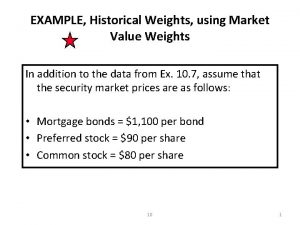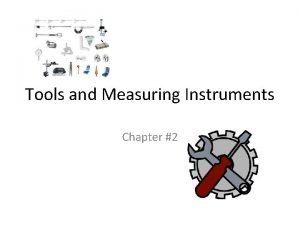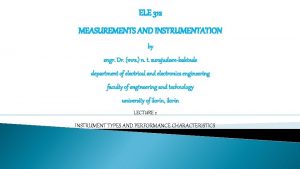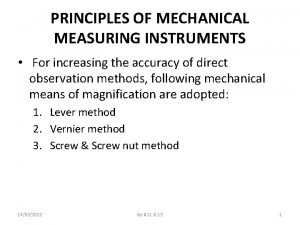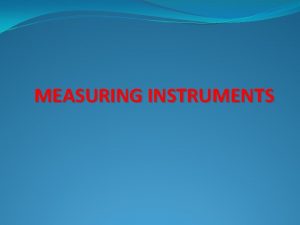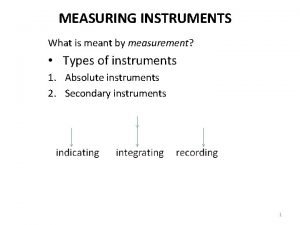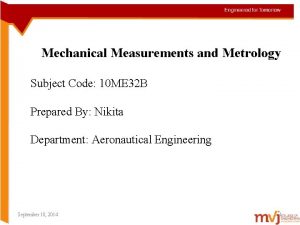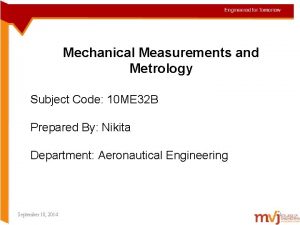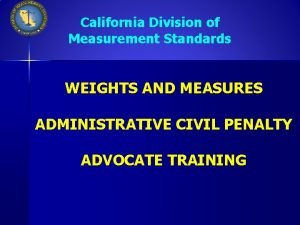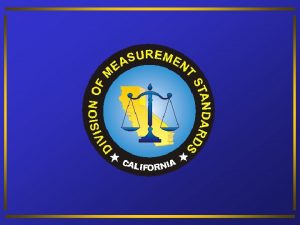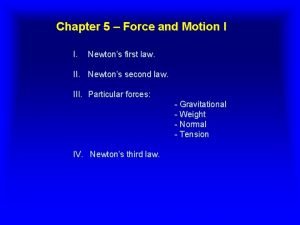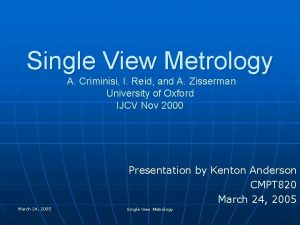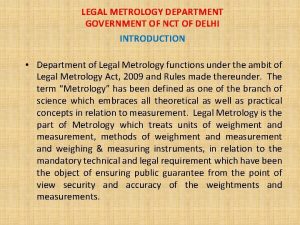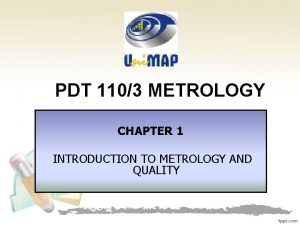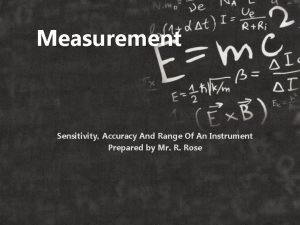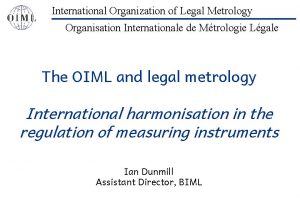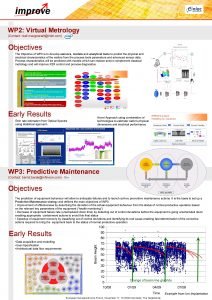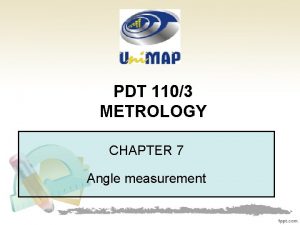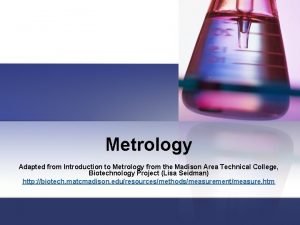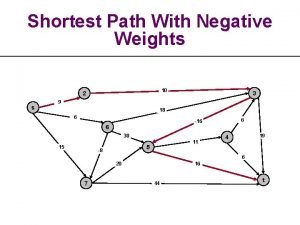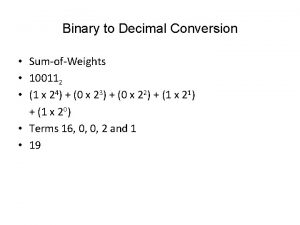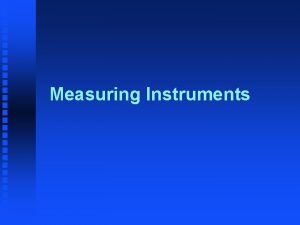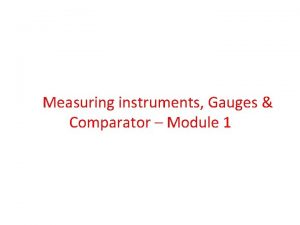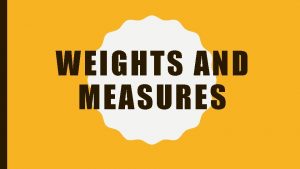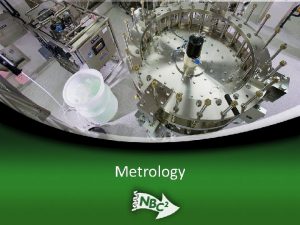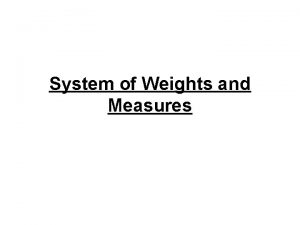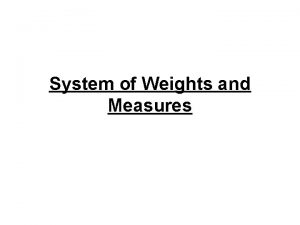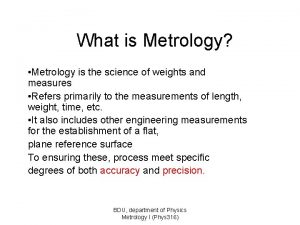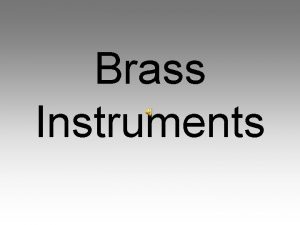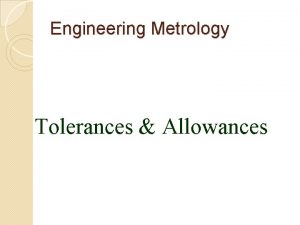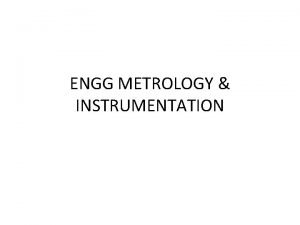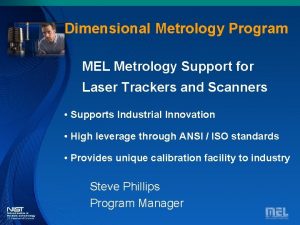Measuring Instruments Metrology n science of weights and





























































- Slides: 61

Measuring Instruments

Metrology n science of weights and measures

Discrimination n degree to which a measuring instrument divides a basic unit of length

10 to one rule for discrimination a measuring instrument should discriminate 10 times finer than the smallest unit that it will be used to measure n instrument lands between two lines do not use to measure n

Parallax error n the apparent shift of an object when viewed from different angles

Calibration n Process by which a measuring instrument is compared to a known standard n The international prototype kilogram is a platinum iridium alloy, created in 1879, that is the standard by which all the world’s weight measurements are calibrated. It is lock in a Paris vault and is only brought out on very rare occasions n The length of a meter is defined by the distance light travels in a vacuum in 1/299, 792, 458 seconds


Handle precision measuring instruments with care

Use of precision measuring instruments keep calibrated n when possible, take readings while the instrument is in contact with the work piece n on cylindrical work pieces, check twice - 90 degrees apart n best temperature is 68 degrees F. n

Variables (Errors)

1. Observational errors misreading the gage n parallax n

2. Manipulative errors holding the gage incorrectly n not locating datums properly n mounting the part on the wrong datums n not aligning the gage properly n measuring pressure /ratchet stops n

3. Bias errors n rounding off

4. Gage errors precision loss (sluggish or sticking indicator) n accuracy loss (incorrect gage block stack, bent micrometer frame, out of calibration error n

5. Part errors Within the piece variation (taper, roundness, etc. ) n dirty parts n poor surface finish n flaws/ burrs n

Direct reading instruments

1. Steel Rules

2. Calipers (Can be Vernier, Dial, or Digital Reading) Outside n Inside n Depth n

3. Micrometers (Can be Vernier, Dial, or Digital Reading) n Outside u frame, Inside n Depth n anvil, spindle, sleeve, thimble

Comparison measuring instruments comparing to a known standard n represents a known distance n used in conjunction with an instrument that has the capability of showing measurement n sometimes referred to as transfer measurement n direct reading instruments should be used whenever possible n

Common types 1. spring calipers n 2. telescoping gages n 3. small hole gages n

4. adjustable parallels n 5. planer gages n

6. thickness gages n 7. radius gages n

Attribute Gages n Go - No Go gages that only tell if the part is good or bad. They don’t provide a measurement of how good or bad.

8. Squares n Machinists Combination Square Set

solid beam square Cylindrical Square

Indicators – 2 Types n a. dial u some can be used to make linear measurement u discriminations range from. 00005 to. 001” u ranges are from. 003 to 2. 0”

n b. test u used for comparisons only (no direct measurements) u discrimination approx. 0005” u range of about. 030”

Indicator Bases n mounting must be rigid u magnetic bases u flexible link holding arms u height gage applications

Surface Plates

Primary measurement is height n measurements are from the plate surface, up

Ideal plane for dimensional measurement should be perfectly flat n nothing is perfect

Surface plate materials n 1. Cast iron u magnetic u if damaged, raised material is produced on surface u easily rust n 2. Granite u far superior u produce no raised material u lower in price

Care of surface plates no unnecessary objects on the surface n clean before and after use n keep it covered n placing and removing objects from the plate n

Accessories Gage blocks (rect. and square) n Angle plate (Knee) n V-blocks n Fixed parallels n Planer gage n 1, 2, 3 Blocks n



Angle Terminology acute angles = < 90 degrees n right angles = 90 degrees n obtuse angles = > degrees n full circle = 360 degrees n 1 degree = 60 minutes of an arc n 1 minute = 60 seconds of an arc n radian = metric unit of angular measurement n

Angle measuring instruments (not for measuring angularity)

1. Plate protractor n discrimination of 1 degree

2. Bevel protractor n part of the machinists combination set - discrimination of 1 degree

3. Universal bevel protractor - vernier n measure to accurately to within 5 minutes of a degree (remember there are 60 minutes in one degree



4. Sine bar n 5” and 10” center spacing of cylinders

To find angles with the sine bar: elevate the sine bar with adjustable parallels until the indicator reads zero at each end of the workpiece n parallel is removed and measured with a micrometer n transpose the sine bar elevation formula and solve for the angle n sin of the angle = elevation / sin bar length (5 or 10”) n

Gage blocks n permit comparison between working measurement & instruments of mfg.

Uses: calibration of measuring instruments n establishment of precise angles (with sine bars) n positioning of machine tools and cutting tools n used to set snap gages n

Common set has 81 to 88 blocks

Range in thickness from. 050 to 4. 0”

3 Grades grade 1 = lab n grade 2 = inspection n grade 3 = shop n

Grade on tolerance = +/. 000002”

Tolerance on a stack of 30 gage blocks assembled to represent 20”?

Use as few combinations as possible when stacking

Care avoid unnecessary contact with hands n clean with proper solvents n handle and lay on lint free cloth n don’t leave blocks rung for extended periods of time n spray with a preservative n

Wringing gage blocks

Main cause of gage block wear is wringing poorly cleaned blocks

Checking with optical flats

Wear blocks used in applications where direct contact is made n usually. 050” or. 100” n

Accessories scribes n bases n screw sets n

Other machines Optical comparator n Coordinate measuring machine (CMM) n
 Historical weights
Historical weights Dental hand instruments chapter 34
Dental hand instruments chapter 34 Direct measurement instruments
Direct measurement instruments Non precision measuring tools
Non precision measuring tools Passive instruments
Passive instruments Indicating instruments and instruments with a signal output
Indicating instruments and instruments with a signal output Mechanical measuring equipment
Mechanical measuring equipment Essentials of indicating instruments
Essentials of indicating instruments Application of voltmeter
Application of voltmeter Wodomierz diehl metering
Wodomierz diehl metering Abbreviation for tablespoon and teaspoon
Abbreviation for tablespoon and teaspoon Your favorite subject
Your favorite subject Saudi standards, metrology and quality organization
Saudi standards, metrology and quality organization Software metrics example
Software metrics example Working principle of tool makers microscope
Working principle of tool makers microscope Metrology and measurements subject code
Metrology and measurements subject code Esma accredited laboratories
Esma accredited laboratories Module 7 weights and measurements
Module 7 weights and measurements Absolute volume formula
Absolute volume formula California weights and measures
California weights and measures Mohenjo daro weights and scales
Mohenjo daro weights and scales California weights and measures
California weights and measures Dr. dudley sargent invented 80 machines, using
Dr. dudley sargent invented 80 machines, using The two blocks a and b have weights
The two blocks a and b have weights What is scientific
What is scientific Single view metrology
Single view metrology Toshiba 1b japanasia
Toshiba 1b japanasia Reliability in metrology
Reliability in metrology Metrology department delhi
Metrology department delhi International metrology organization headquarters
International metrology organization headquarters Metrology
Metrology Introduction to metrology
Introduction to metrology Pakistan meteorological department
Pakistan meteorological department Sensitivity of an instrument
Sensitivity of an instrument International organisation of legal metrology
International organisation of legal metrology Forensic metrology
Forensic metrology Metrology
Metrology Metrology
Metrology Ebbing metrology
Ebbing metrology Conclusion on meteorological instruments
Conclusion on meteorological instruments Interchangeability definition in metrology
Interchangeability definition in metrology Define allowance in metrology
Define allowance in metrology Selective assembly in metrology
Selective assembly in metrology Virtual metrology
Virtual metrology Sine table in metrology
Sine table in metrology Introduction of metrology
Introduction of metrology Introduction to metrology
Introduction to metrology Optical metrology techniques
Optical metrology techniques International organisation of legal metrology
International organisation of legal metrology Ipfraking
Ipfraking Akaike weights
Akaike weights Akaike weights
Akaike weights Akaike weights
Akaike weights Allergy therapy makes bees go away
Allergy therapy makes bees go away Portfolio weights
Portfolio weights Arhousr
Arhousr Weight scale ticket
Weight scale ticket Tramp steamer problem
Tramp steamer problem Binary multiplication
Binary multiplication Multiplicative weights update algorithm
Multiplicative weights update algorithm Comparing weights
Comparing weights Greg filbeck
Greg filbeck
